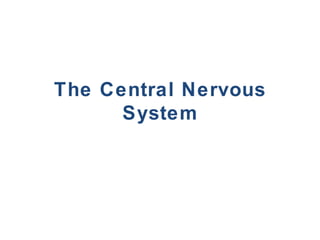
5. cns 1
- 1. The Central Nervous System
- 2. Brain Central nervous system (CNS) Spinal cord Peripheral nervous system (PNS) Afferent division Efferent division Sensory stimuli Visceral stimuli Somatic nervous system Autonomic nervous system Motor neurons Sympathetic nervous system Parasympathetic nervous system Skeletal muscle Smooth muscle Cardiac muscle Glands Effector organs (made up of muscle and gland tissue) ( Input to CNS from periphery) ( Output from CNS to periphery)
- 9. Central nervous system (spinal cord) Peripheral nervous system Axon terminals Cell body Afferent neuron Central axon Peripheral axon (afferent fiber) R eceptor Interneuron Efferent neuron Effector organ (muscle or gland) Axon (efferent fiber) Axon terminals * Efferent autonomic nerve pathways consist of a two-neuron chain b etween the CNS and the effector organ. Cell body
- 16. Hypothalamus Brain stem Cerebral cortex Thalamus (medial) Basal nuclei (lateral to thalamus) Cerebellum Spinal cord Midbrain Pons Medulla Brain component Cerebral cortex Basal nuclei Thalamus Hypothalamus Cerebellum Brain stem (midbrain, pons, and medulla)
- 25. Top Front of brain Corpus callosum Cerebral cortex Thalamus (wall of third ventricular cavity) Pineal gland Cerebellum Part of the limbic system Bridge that connects the two halves of the thalamus Hypothalamus Pituitary gland Brain stem Spinal cord
- 26. Brain stem Cerebellum Vestibulocerebellum Spinocerebellum Cerebrocerebelum
- 27. Unfolded Regulation of muscle tone, coordination of skilled voluntary movement Planning and initiation of voluntary activity Maintenance of balance, control of eye movements Vestibulocerebellum Spinocerebellum Cerebrocerebelum
- 28. Motor cortex Spinocerebellum Informed of motor command Makes adjustments as necessary Motor command to muscles Informed of actual performance Activates receptors in muscles and joints Movement Skeletal muscles
- 30. Major Functions 1. Sensory perception 2. Voluntary control of movement 3. Language 4. Personality traits 5. Sophisticated mental events, such as thinking memory, decision making, creativity, and self-consciousness 1. Inhibition of muscle tone 2. Coordination of slow, sustained movements 3. Suppression of useless patterns of movements 1. Relay station for all synaptic input 2. Crude awareness of sensation 3. Some degree of consciousness 4. Role in motor control 1. Regualtion of many homeostatic functions, such as temperature control, thirst, urine output, and food intake 2. Important link between nervous and endocrine systems 3. Extensive involvement with emotion and basic behavioral patterns 1. Maintenance of balance 2. Enhancement of muscle tone 3. Coordination and planning of skilled voluntary muscle activity 1. Origin of majority of peripheral cranial nerves 2. Cardiovascular, respiratory, and digestive control centers 3. Regulation of muscle reflexes involved with equilibrium and posture 4. Reception and integration of all synaptic input from spinal cord; arousal and activation of cerebral cortex 5. Role in sleep-wake cycle Brain component Cerebral cortex Basal nuclei Thalamus Hypothalamus Cerebellum Brain stem (midbrain, pons, and medulla)
- 31. Reticular activating system Visual impulses Reticular formation Brain stem Ascending sensory tracts Descending motor tracts Spinal cord Auditory impulses Cerebellum
- 33. The spinal cord consists of inner gray matter and outer white matter.
